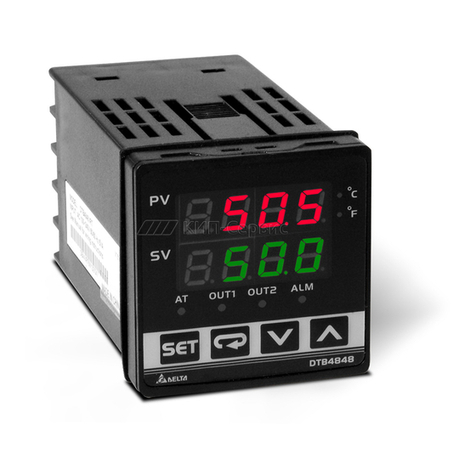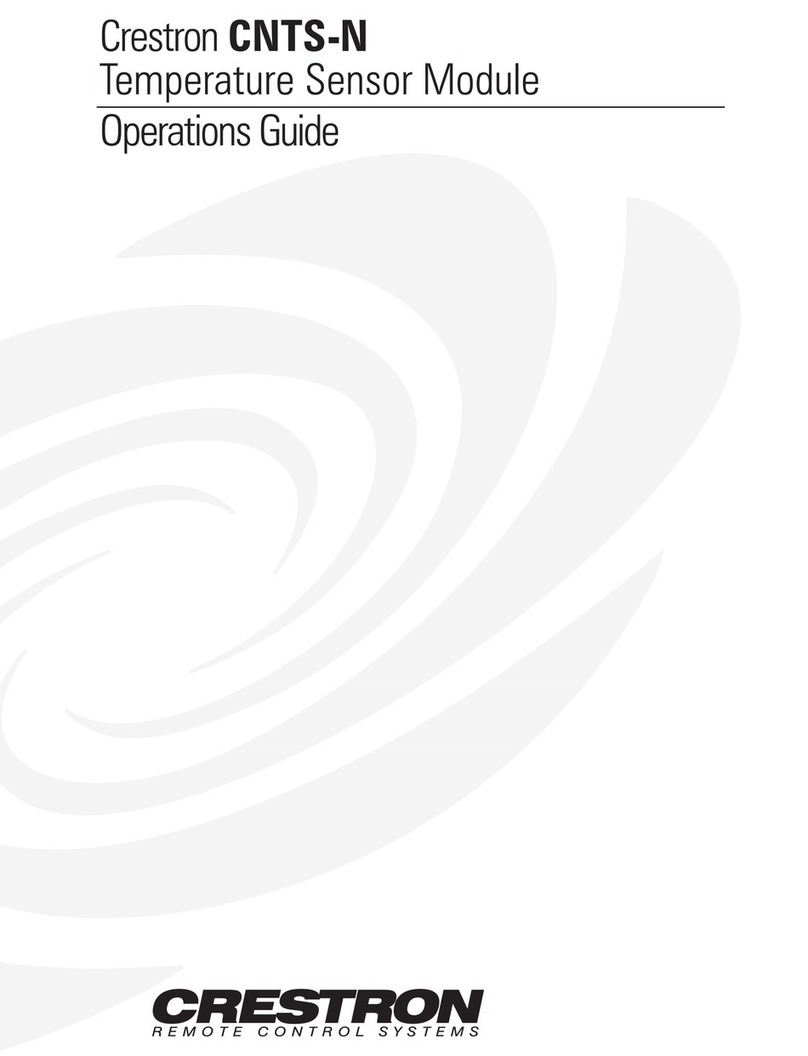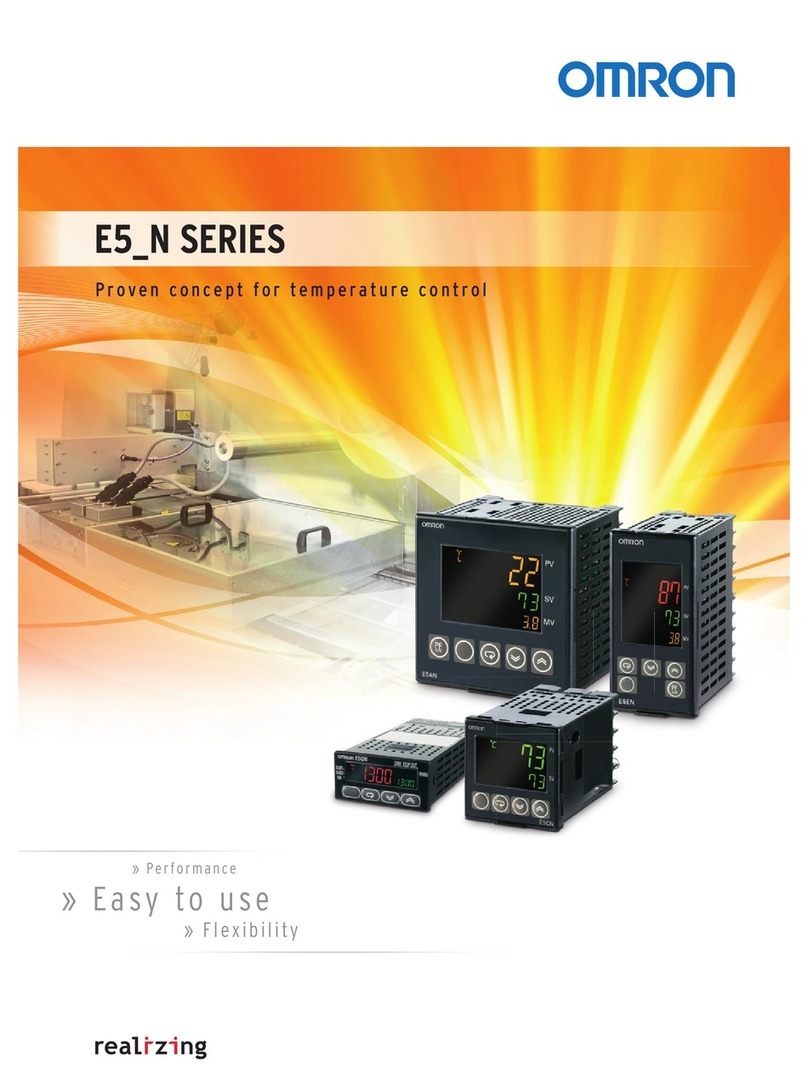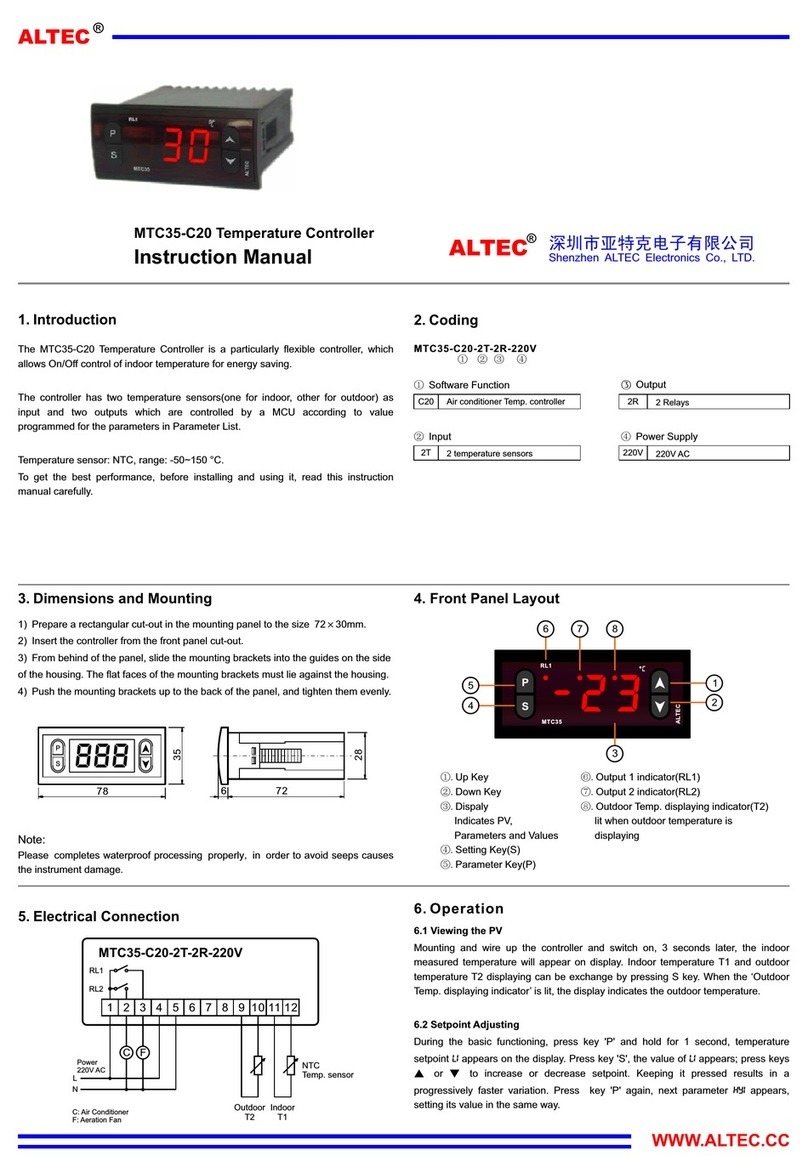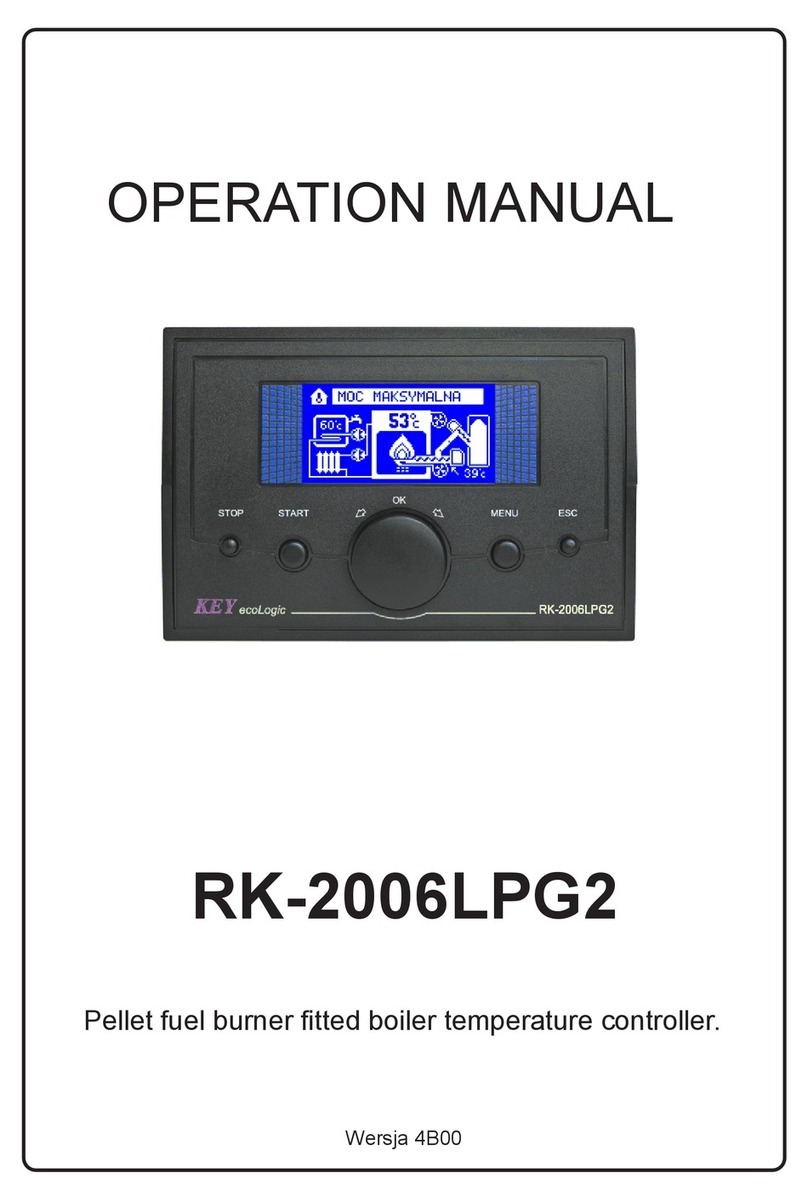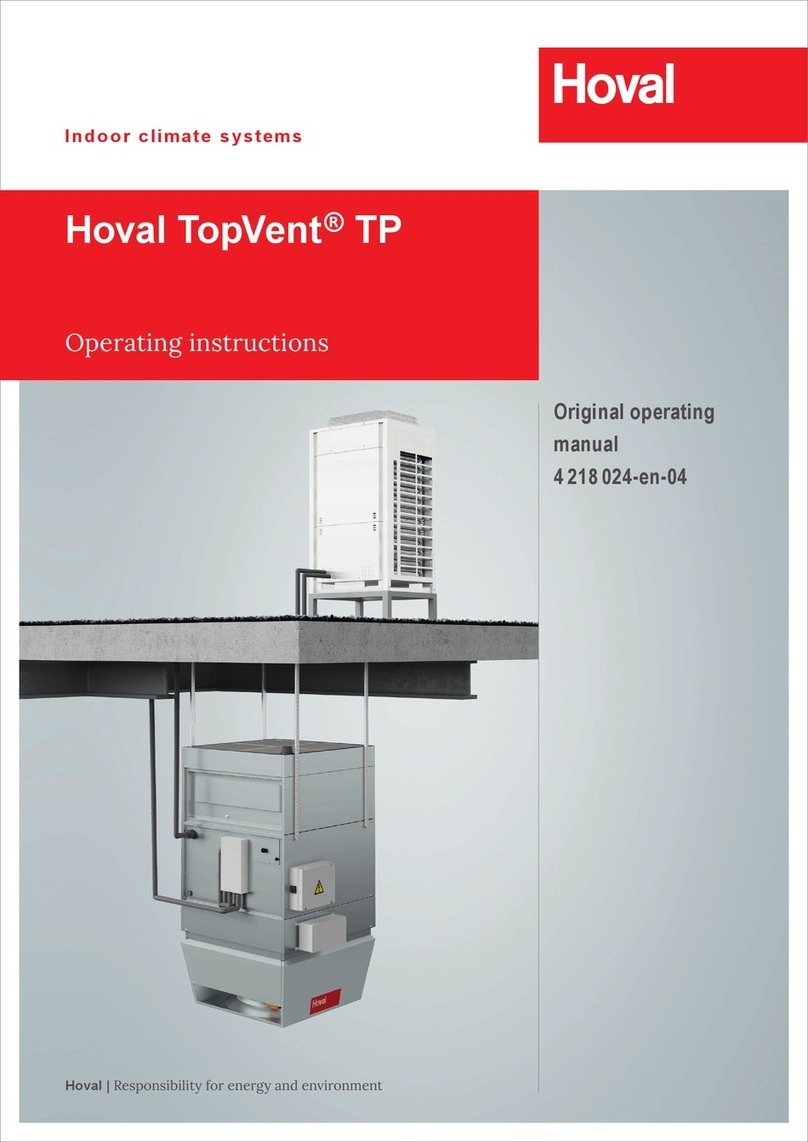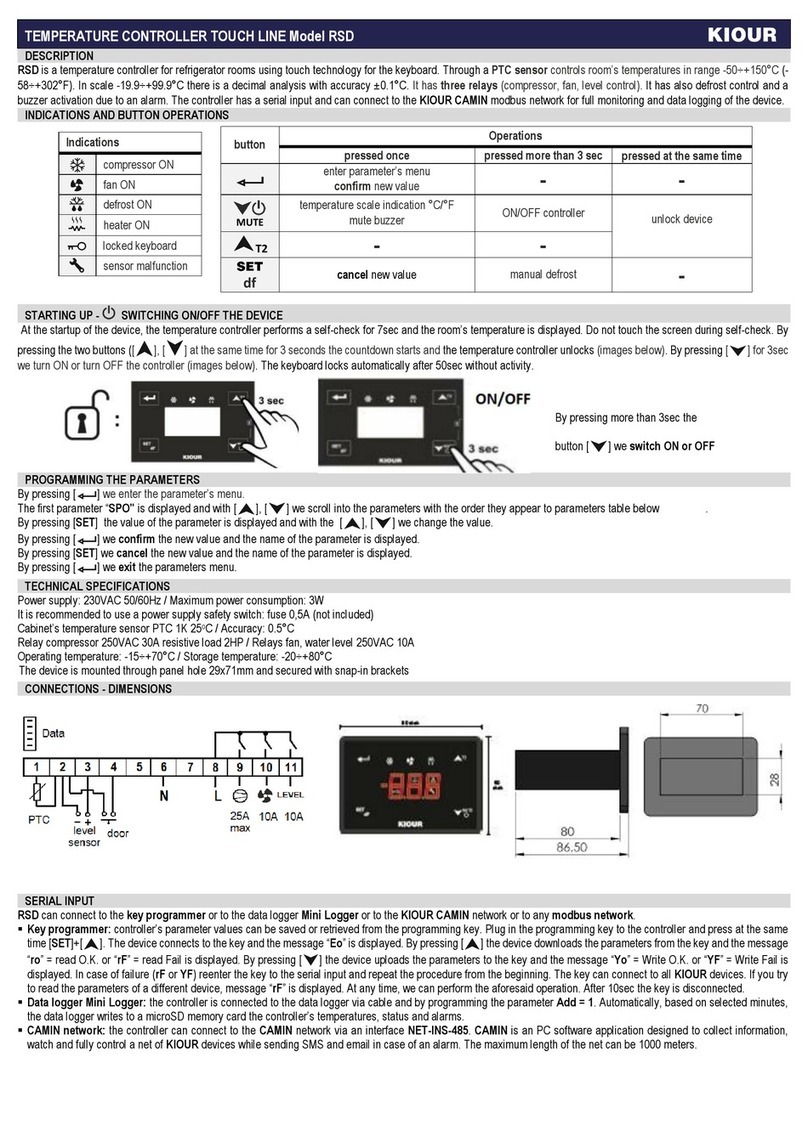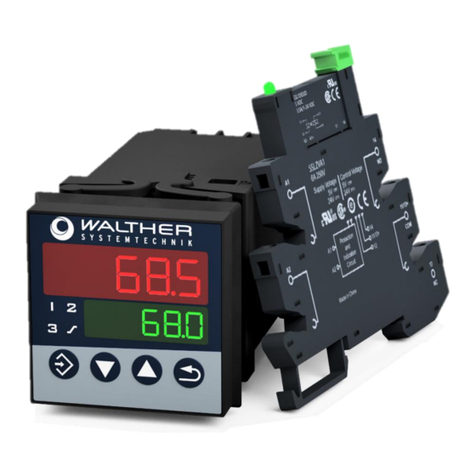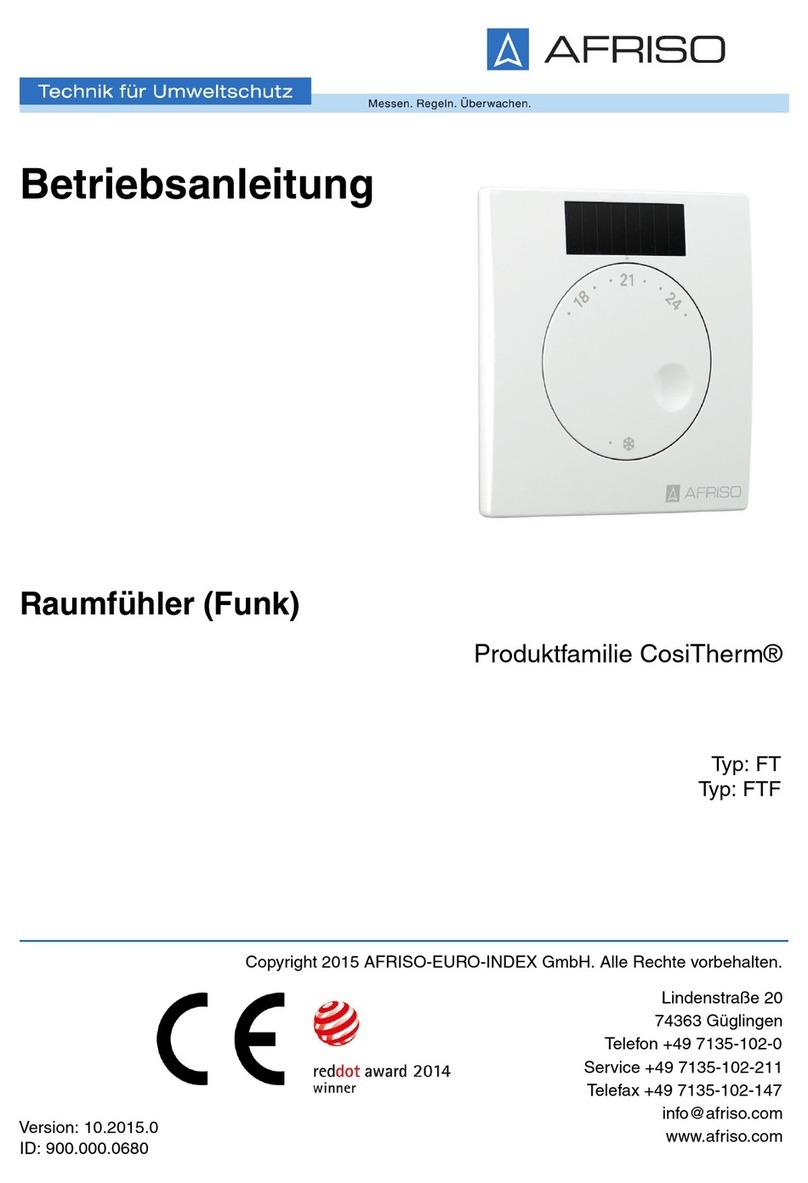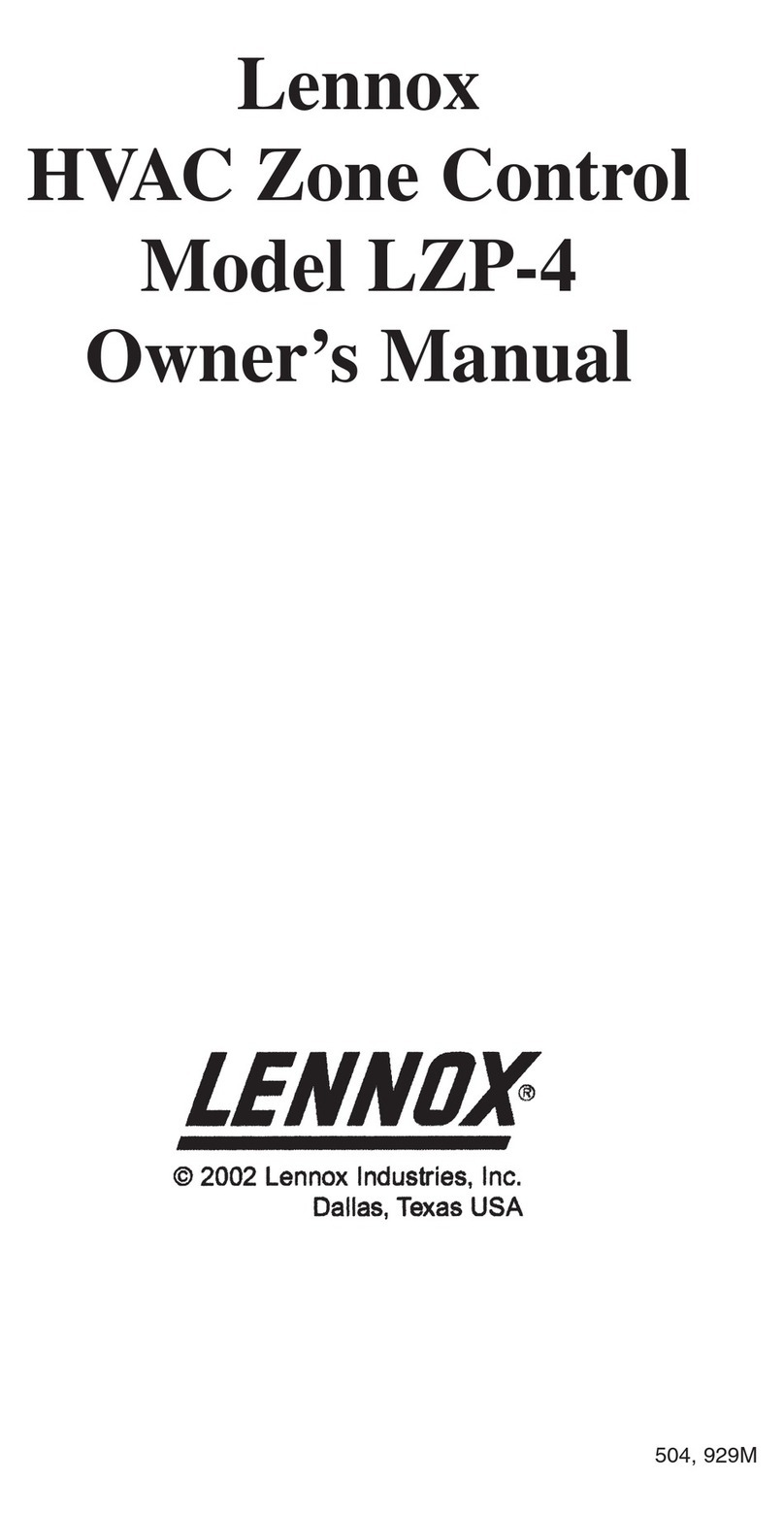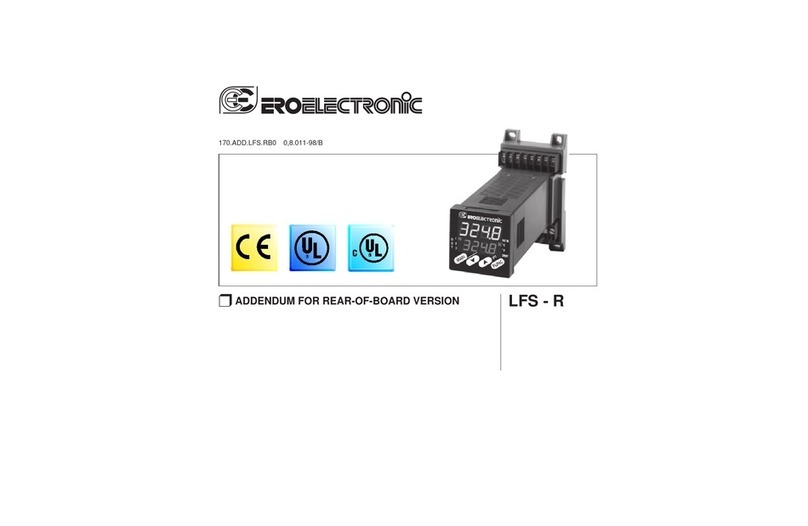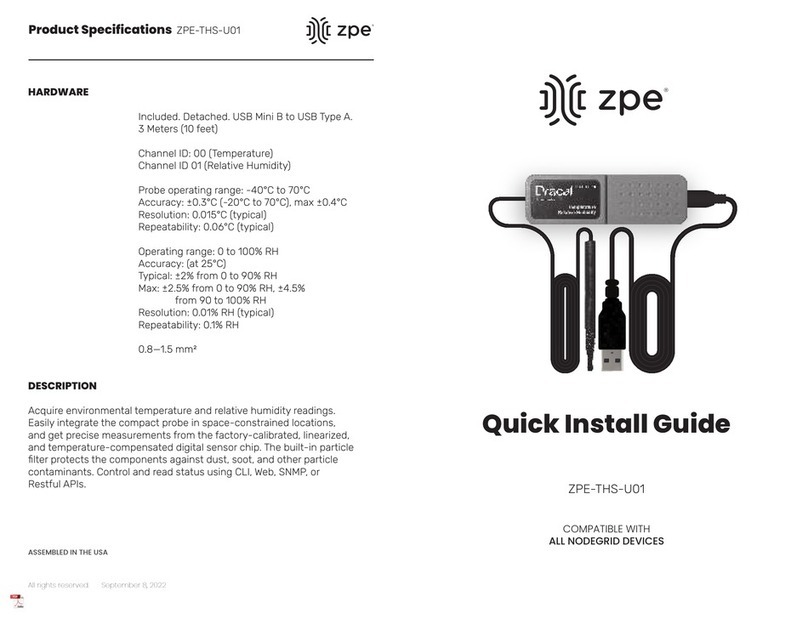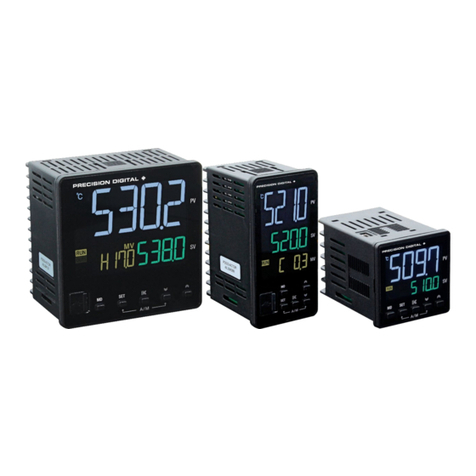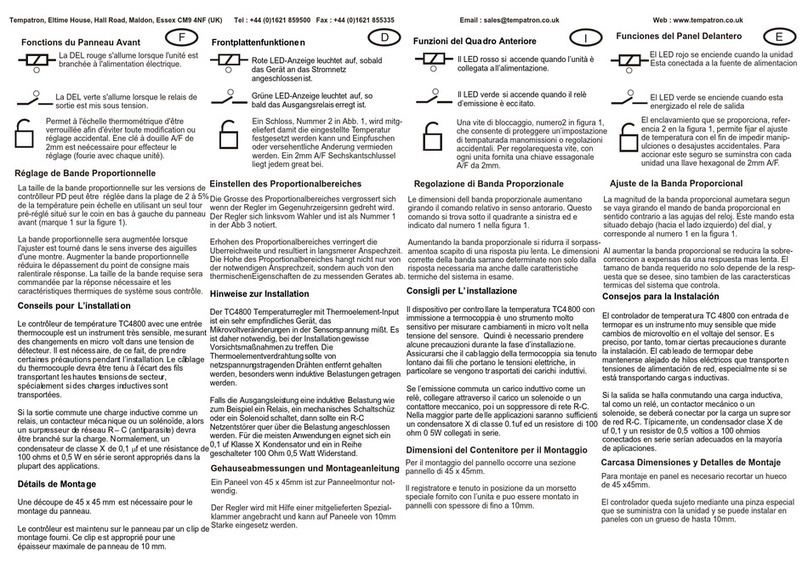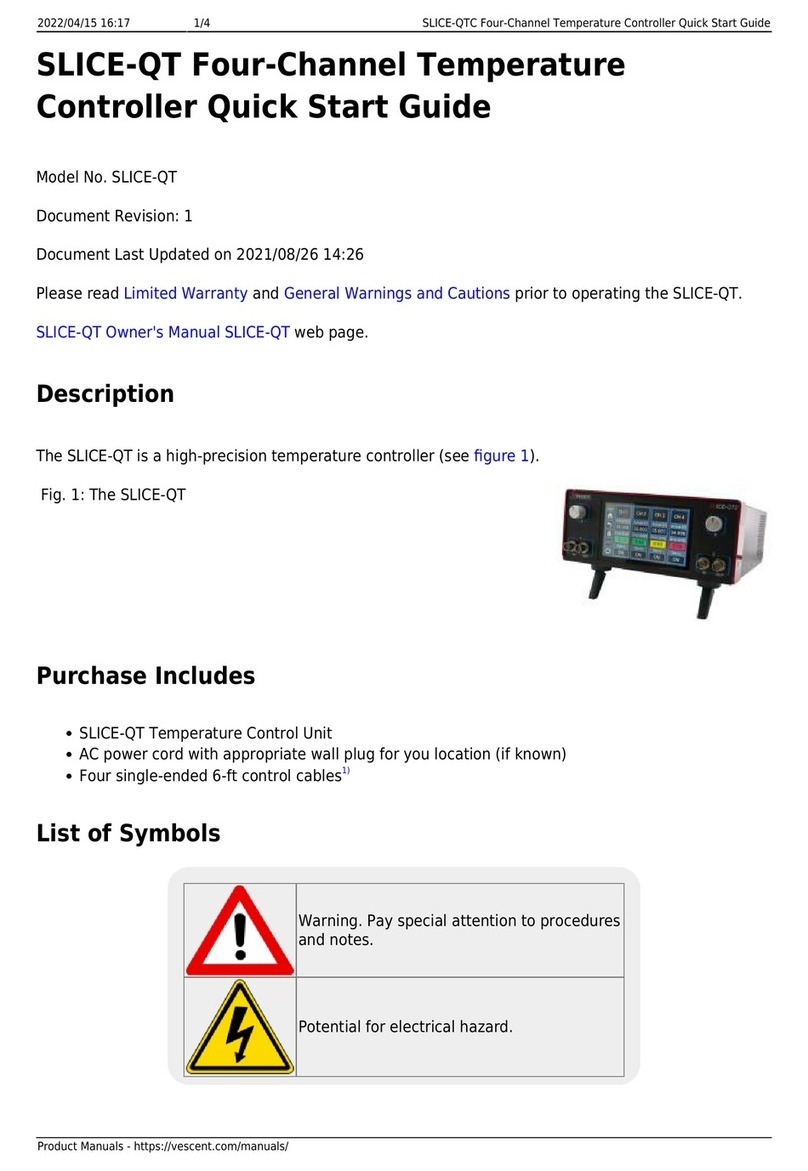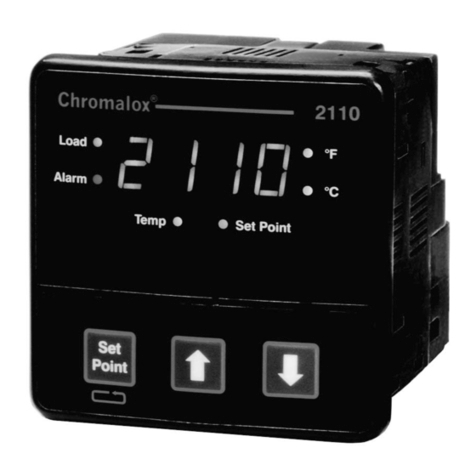Delta DTK Series User manual

1
2015/4/8
Series Temperature Controller Instruction Sheet
Precaution
DANGER! Caution! Electric Shock! Do not touch the AC terminals while the power is supplied to the controller to prevent electric
shock. Make sure power is disconnected while checking the unit inside.
This controller is an open-type temperature controller. Be sure to evaluate any dangerous application in which a serious human
injury or serious property damage may occur.
1. Always use recommended solder-less terminals: Fork terminal with isolation (M3 screw, width is 7.2 mm). Make sure all wires are
connected to the correct polarity of terminals.
2. Do not allow dust or foreign objects to fall inside the controller to prevent it from malfunctioning. Never modify or disassemble the
controller. Do not connect anything to the "No used" terminals.
3. To prevent interference, keep away from high voltage and high frequency when installing. Do not install and/or use the controller in
places subject to:
(a) Dust or corrosive gases and liquid; (b) High humidity and high radiation; (c) Vibration and shock;
4. Power must be off when wiring and replacing a temperature sensor.
5. Be sure to use compensating wires that match the thermocouple types when extending or connecting the thermocouple wires.
6. Please use wires with resistance when extending or connecting a platinum resistance thermometer (RTD).
7. Please keep the wire as short as possible when wiring a platinum resistance thermometer (RTD) to the controller and please route
power wires as far as possible from load wires to prevent interference and induced noise.
8. This controller is an open-type unit and must be placed in an enclosure away from high temperature, humidity, dripping water,
corrosive materials, airborne dust, and electric shock or vibration.
9. Make sure power cables and signals from instruments are all installed properly before energizing the controller, otherwise serious
damage may occur.
10. Do not touch the terminals in the controller or try to repair the controller when power is on, in order to prevent electric shock.
11. Wait at least one minute after power is disconnected to allow capacitors to discharge, and please do not touch any internal circuit
within this period.
12. Do not use acid or alkaline liquids for cleaning. Please use a soft, dry cloth to clean the controller.
Display, LED & Pushbuttons
PV: Present value
SV: Set value
Ԩ, Ԭ: Celsius or Fahrenheit LED
1, 2: ALM1/ALM2 alarm output LED
A/M: Auto-Tuning and manual mode LED
OUT1, OUT2: Output LED
: "Select" and "Set up" keys
:"Set value tuning" keys

2
Ordering Information
DTK 1 2 3 4 5 6 7
Series DTK: Delta DTK Series Temperature Controller
Panel Size (W×H)
4848:4848 1/16 DIN W48 × H48mm
7272:7272 W72 × H72mm
4896:4896 1/8 DIN W48 × H96mm
9696:9696 1/4 DIN W96 × H96mm
Output options
R: Relay output, 250 VAC, 8A
V: Voltage pulse output 12VDC +/-15%
C: DC current output, 4 ~ 20 mA
Communication option 0: None
1: RS485 communication
Alarm option
0: None
1: 1 alarm output
2: 2 alarm output
Specifications
Input Voltage AC 100 ~ 240 V, 50/60 Hz
Power Consumption 5VA max.
Display Method LCD display.Process value (PV): Red color, Set point (SV): Green color
Sensor Type
Thermocouple: K, J, T, E, N, R, S, B, L, U, TXK
3-wire Platinum RTD: Pt100, JPt100
Resistance: Cu50, Ni120
Control Mode PID, manual, and ON/OFF
Control Output
Relay output: Max. load 250VAC, 5A resistive load
Voltage pulse output: DC 12V, Max. output current 40 mA
Current output: DC 4 ~ 20 mA output (Load resistance: Max. 600Ω)
Alarm Output Type Relay output: Max. load 250VAC, 5A resistive load
Display Accuracy 0 or 1 digit to the right of the decimal point (selectable)
Sampling Rate Thermocouple or platinum resistor: 0.1 sec
Vibration Resistance 10 to 55 Hz, 10 m/s2 for 10 min, each in X, Y, and Z directions
Shock Resistance Max. 300 m/s2, 3 times in each of 3 axes, 6 directions
Ambient Temperature 0°C ~ +50°C
Storage Temperature -20°C ~ +65°C
Altitude Max. 2000 m
Relative Humidity 35% ~ 80% RH (non-condensing)
Operation
There are three modes of operation: operation, regulation, and initial setting. When power is applied, controller gets into the operation
mode. Press the key to switch to regulation mode. If the key is pressed for more than 3 seconds, controller will switch to
the initial setting mode. Pressing the key while in the regulation mode or initial setting mode forces the controller to return to the
operation mode.
PV/SV: Sets the temperature set point and displays the temperature process value. Use keys to set the temperature set
point.
Setting method: While in any function mode, press the key to select the desired function and use keys to change the
settings. Press key to save the changes.
The flow chart below shows how to switch the settings and internal functions:
Regulation Mode Operation Mode Initial Setting Mode
Press key less than 3 sec
Press key
Press key more than 3 sec
Press key

3
Parameter Settings for Operation Mode:
Display Description Factory
Setting
Use to set temperature set point. Press to switch between display parameters.
RUN/STOP: Control setting RUN/STOP RUN
SELECT POINT: Decimal point setting (0: integral; 1: one decimal point) 0
LOCK: Setting lock mode (LOCK1: all; LOCK2: only SV is allowed) OFF
ALARM1 HIGH: Upper limit alarm 1 (display according to the setting in ALARM mode) 4.0
ALARM1 LOW: Lower limit alarm 1 (display according to the setting in ALARM mode) 4.0
ALARM2 HIGH: Upper limit alarm 2 (display according to the setting in ALARM mode) 4.0
ALARM2 LOW: Lower limit alarm 2 (display according to the setting in ALARM mode) 4.0
OUT1: Display and adjust output value of 1st output group 0.0
OUT2: Display and adjust output value of 2nd output group
(display when OUT2 is set to Heating/Cooling Mode) 0.0
OUT1 MAX.: Upper limit % of 1st output group (perform linear calculation again) 100.0
OUT1 MIN.: Lower limit % of 1st output group 0.0
OUT2 MAX: Upper limit % of 2nd output group (display when OUT2 is set to Heating/Cooling Mode) 100.0
OUT2 MIN: Lower limit % of 2nd output group (display when OUT2 is set to Heating/Cooling Mode)
Press to return to target temperature setting. 0.0
Parameter Settings for Initial Setting Mode:
Display Description Factory
Setting
INPUT: Set input type (refer to "Temperature Sensor Type & Temperature Range Chart" for the selection
of Thermocouple or Platinum Resistance types.) K
TEMP. UNIT: Set temperature unit Ԩ/ԬԨ
TEMP. HIGH: Set up upper temperature limit
(the upper limit setting is different for different types of sensors) 1300
TEMP. LOW: Set up lower temperature limit
(the lower limit setting is different for different types of sensors) -200
CONTROL: Select control modes (3 different modes: ON-OFF, PID, and MANUAL) PID
SELECT HEAT/COOL: Select heating, cooling or dual-output heating and cooling. H1
ALARM1 SET: Set up Alarm 1 mode (refer to "Alarm Outputs") 0
ALARM1 OPTION: Set up Alarm 1 options (refer to "Alarm Outputs") 0
ALARM1 DELAY: Set up Alarm 1 delay 0
ALARM2 SET: Set up Alarm 2 mode (refer to "Alarm Outputs") 0
ALARM2 OPTION: Set up Alarm 2 options (refer to "Alarm Outputs") 0
ALARM2 DELAY: Set up Alarm 2 delay 0
COMMUNICATION WRITE: Enable/disable communication write-in NO
COMMUNICATION SELECT: Select ASCII or RTU format ASCII
COMMUNICATION NO.: Set up communication address 1
BPS: Set up baudrate 9600
LENGTH: Set up data length 7
STOP: Set up stop bit 1
PARITY:Setupparitybit Press to return to input type setting. EVEN

4
Parameter Settings for Regulation Mode:
Display Description Factory
Setting
AT: Auto-tuning Switch (display when setting Ctrl = PID/RUN) Press . OFF
P: Proportional Setting (display when setting Ctrl = PID and TUNE = AT) 47.6
I: Integral Time Setting (display when Crtl = PID; this parameter is set automatically when TUNE = AT.) 260
D: Deviation Time Setting
(display when Crtl = PID; this parameter is set automatically when TUNE = AT.) 41
PD OFFSET: PD offset when Integral = 0 to eliminate a consistent deviation.(display when Crtl = PID;
this parameter is set automatically when TUNE = AT.) 50.0
OUT1 HYSTERESIS: Adjust Output 1 hysteresis (when in ON/OFF control) 0
OUT2 HYSTERESIS: Adjust Output 2 hysteresis (when in ON/OFF control) 0
OUT1 HEAT: Heating control cycle for Output 1 (when Ctrl = PID/MANUAL) Output
selection:
C; V: 5 sec.
R output
20 seconds
OUT1 COOL: Cooling control cycle for Output 1 (when Ctrl = PID/MANUAL)
OUT2 HEAT: Heating control cycle for Output 2 (when Ctrl = PID/MANUAL)
OUT2 COOL: Cooling control cycle for Output 2 (when Ctrl = PID/MANUAL)
COEF: Ratio of Output 1 against Output 2 (when Ctrl = PID and when in dual output control) 1.00
DEAD: Set up deadband (when Ctrl is not set to MANUAL and when in dual output) 0
PV FILTER: Set up input filter factor of PV 2
PV RANGE: Set up input filter range of PV 1.00
PV OFFSET: Adjust input compensation of PV 0.0
PV GAIN: Adjust input gain of PV 0.000
ANALOG OUT1 MAX.: Adjust upper limit compensation for analog Output 1
(1 scale = 1 μA; 1 scale = 1 mV) 0
ANALOG OUT1 MIN.: Adjust lower limit compensation for analog Output 1
(1 scale = 1 μA; 1 scale = 1 mV) 0
Initial Start-up Setting
When setting up DTK for the first time, press key for more than 3 seconds till the screen display and select according to
your temperature sensor type. Please be aware that incorrect selection of a model would cause PV temperature display error. (Refer to
the chart below)
When setting up the temperature sensor type by using RS-485, write your value (range 0~14) into register 1004H.
Temperature Sensor Type & Temperature Range Chart
Input Temperature
Sensor Type Register Value Temperature Range Input Temperature Sensor Type Register Value Temperature Range
Thermocouple K type 0 -200 ~ 1300°C Thermocouple L type 8 -200 ~ 850°C
Thermocouple J type 1 -100 ~ 1200°C Thermocouple U type 9 -200 ~ 500°C
Thermocouple T type 2 -200 ~ 400°C Thermocouple TXK type 10 -200 ~ 800°C
Thermocouple E type 3 0 ~ 600°C Platinum Resistance (JPt100) 11 -100 ~ 400°C
Thermocouple N type 4 -200 ~ 1300°C Platinum Resistance (Pt100) 12 -200 ~ 850°C
Thermocouple R type 5 0 ~ 1700°C Resistance (Ni120) 13 -80 ~ 300°C
Thermocouple S type 6 0 ~ 1700°C Resistance (Cu50) 14 -50 ~ 150°C
Thermocouple B type 7 100 ~ 1800°C
Display Unit Setting
Use following parameter to change the PV and SV display unit, select decimal point and switch between Ԩ/Ԭ.
In Operation Mode parameter : SP = 1 displays decimal place (ex: 25.5 degree); SP = 0 displays integral number (ex: 25
degree).
In Initial Setting Mode parameter : Select temperature display unit Ԩ/Ԭ. (Ԭ=Ԩ* 9 / 5 + 32)

5
Set Value and Upper/Lower Limit of the Input Value
SV setting serves as reference for control.
Set the Upper Limit of Input Value: In Initial Setting Mode parameter ,the upper limit input value must be set within the range
shown in the chart "Temperature Sensor Type & Temperature Range".
Set the Lower Limit of Input Value: In Initial Setting Mode parameter , the upper limit input value must be set within the range
shown in the chart "Temperature Sensor Type & Temperature Range".
Set the SV: This parameter can be set in Operation Mode. SV value must be set within the range for upper/lower limit of the input
value.
Digital Filter and Linear Compensation Setting
To avoid interferences on input signal that would cause instable display value, two parameters are provided below for users to set up with.
In Regulation Mode, parameters and can be used to adjust filter status.
Filter Factors (setting range = 0~50; factory setting = 2). Linear Compensation Gain Calculation equation: PV = (Last
displayed PV * n + Measured Value) / (n+1).
When the parameter value is small, the PV display is close to the Measured Value. When the parameter value is large, the PV
response is slow.
Filter Range (setting range = 0.10~10.00 ).If factory setting = 1, it means the controller will begin Digital Filter Calcaula℃tion
when the Measured Value lies within the range of "Last displayed PV + / - 1.00 ". Therefore, it is recommended to set a larger value℃
when noise interference is serious enough to cause large temperature oscillations.
When PV display value is different from user's expectation, Linear Compensation can be adjusted via parameters and
in Regulation Mode.
Linear Compensation Value (setting range = -99.9 ~ 99.9). Linear Compensation Gain Calculation equation: PV = Measured
Value + Compensation Value.
For example: Measure Value = 25.0; Compensation = 1.2. After applying to the Compensation equation PV = 26.2.
Linear Compensation Gain (setting range = 0~0.999). Linear Compensation Gain Calculation equation: PV = Measured
Value * (1 + Gain/1.000) + Compensation.
For example: Measured Value = 25.0; Gain = 0.100. After applying to the Gain calculation equation PV = 25.0 * (1 + 0.100 / 1.000) =
27.5.
If temperature deviation is the same in every temperature, setting linear compensation value solves the deviation issue. If temperature
deviation varies upon different temperatures, calculate the linear deviation error and adjust the temperature by setting Gain and
Compensation value.
Analog Output Compensation
When the output mode is set to analog current output (4~20 mA), user's desired output value can be obtained by using compensation
function. For example, the analog output 1 can be adjusted for compensation in parameters and in Regulation Mode.
The output value can be positive or negative (+/-) and can be changed by pressing the Up/Down key on the temperature controller. The
scale of each pressing is an increase or decrease of 1 uA. Ex: To change the current output range from 4~20 mA to 3.9~20.5 mA, set
parameter to 500. (20.5-20=0.5mA; 0.5mA/1uA= 500)
Set parameter to -100. (3.9-4=-0.1mA; -0.1mA/1uA=-100)
To control the output manually: Set parameter to in Initial Setting Mode.
To set output to 0%: Set parameter (output 1) or (output 2) to in Operation Mode.
To adjust the lower limit of analog output: Input a desired value and check the meter to adjust the analog input value to the desired
value (for example: 4~20 mA, adjusting analog value will be 4 mA). Set parameter to your desired value in Regulation
Mode.
To set output to 100%: Set parameter (Output 1) or to in Operation Mode.
To adjust the upper limit of analog output: Input a desired value and check the meter to adjust the analog input value to the desired
value (for example: 4~20 mA, adjusting analog value will be 20 mA). Set parameter to your desired value in Regulation
Mode.
Check Firmware Version and Output Type
When the temperature controller is ON, the PV and SV display will show firmware version, output type, and input type during the first 3
seconds.
PV indicates the firmware version. Ex: V110 indicates firmware version V1.10.
SV (first digit) indicates the output type of OUT1.
N: No function, V: Voltage pulse output, R: Relay output, C: Current output
SV (second digit) indicates the output type of OUT2. No display: No OUT2 (default), R: Relay output
The 3rd and 4th SV digit are input types.
K, J, T, E, N, R, S, B, L, U, TX (TXK), JP (JPT100), PT (Pt100), CU (CU50), NI (NI120)

6
Selection for Heating/Cooling/Alarm/Dual-Loop Output Control
DTK series features 1 set of Output Control (OUT1) and 1 set of Alarm Output (ALARM1), both of which are built-in. Users can also
purchase a 2nd set of Alarm Output (ALARM2).
Using 1 set of Output Control:
In Initial Setting Mode, set parameter to Heating (H1) or Cooling (C1) mode.
Using 2nd set of Output Control:
When the 1st set of alarm and the 2nd set of output control are used for dual output control, set parameter in Initial
Setting Mode to controls such as heating (H1H2), cooling (C1C2), heating/cooling (H1C2), or cooling/heating (C1H2).
The Dead Band parameter is automatically enabled when the temperature controller is in dual output control. As shown in the
diagram below, the purpose for setting the Dead Band function is to reduce waste of energy from frequent acts of heating/cooling. Ex: For
example, if SV = 100 degree and = 2.0, there will be no output when the temperature is between 99~101°C.
Output of when in ON-OFF control mode (Ctrl = ON-OFF control):
Output of when in PID control mode (Ctrl = PID):
When the controller is in PID control and dual loop output mode, parameter sets the P value of the 2nd set of PID. The
1st set of PID is generated when TUNE = AT, but user can also manually set the PID value. The P value of the 2nd set of PID = the
P value of 1st set of PID x . The I and D value of the 2nd set of PID remains the same as the 1st set of PID.
Control Mode Setting
There are 3 control modes, which are ON-OFF, PID, and MANUAL.
ON-OFF Mode: For heating output, the output is off when input is greater than the setting value; output is on when input is smaller
than (setting value - adjustment sensitivity setting value). For cooling output, the output is on when the input is greater than (setting
value + adjustment sensitivity setting value); output is off when input is smaller than the setting value. If one of 2 outputs is set for
heating and the other for cooling, a non-action zone can be set as shown in the diagram below.
Set parameter to in Initial Setting Mode.
Set adjustment sensitivity: Via parameter in Regulation Mode, set adjustment sensitivity (output 1),
Adjust heating Adjust cooling
Heatin Coolin
Set Point
Heatin Coolin
Set Point Set Point
Heating Cooling
Dead Band
Adjust heating Adjust cooling
Heating Cooling
Set Value
(Output ON-OFF control for both actions)

7
(output 2).
Setting of Dead Band for both outputs: Set Dead Band via parameter in Regulation Mode.
PID Mode: When setting for heating or cooling, the program performs PID operation via input temperature and setting temperature,
with the operation result output for control of the temperature. A PID parameter and control period must be set for this function;
these parameters can also be generated automatically via auto-tuning (AT).
a. Set PID parameters and the control period: PID parameters can be adjusted manually according to system characteristics or
created automatically by AT. Proportional error compensation is used when I parameter is set to 0 for adjusting reduced
deviation from time to reach the temperature.The Control Period is the period of PID operation, if the control period is 10
seconds, it means a PID operation is carried out every 10 seconds. The result is then output to control the temperature.If the
system heats up quickly, the control period shall not be set too long. For relay output, lifespan of the relay shall be considered.
A short control period will shorten the lifespan of relay.
b. Coef and DeadBand are added in the PID parameter for double output (one for heating and one for cooling). Coef refers to
the ratio between the first and second portions of output (P parameter of second group = Coef*P, Coef = 0.01~99.99).
DeadBand is the overlapping temperature of the P output for the first and second group.
Set parameter to in Initial Setting Mode.
To set for heating or cooling control: Select desired output control via parameter in Initial Setting Mode. If only
single output control is performed, items to be selected are H1 and C1 (H for heating, C for cooling, and 1 for output 1). If
dual output control is performed, the items to be selected are as follows: H1H2, C1H2,... C1C2 (H for heating, C for cooling,
1 for output 1, and 2 for output 2).
Set control period: In Regulation Mode parameter, PV is displayed as "o'x' - 'y'". 'x' is 1 (output 1) or 2 (output 2). 'y' is H
(heating) or C (cooling).
Set double output Coef: Set Coef value via parameter in Regulation Mode.
Setting of Dead Band for both outputs: Set Dead Band via parameter in Regulation Mode.
Set control to running mode: Set parameter to in Operation Mode.
Set AT: Set parameter to in Regulation Mode. The selected number of PID sets will be adjusted
automatically. After that, a PID value will be created automatically and the display will automatically alter into .
Note: When performing AT, set up for the entire system must be completed, i.e. the input sensor must be wired and correctly set,
and the output must be connected to a heater or cooler pipe.
MANUAL Mode: Manual control function may force output of a fixed value. However, it is normally operated in combination with
switchover of PID control.
a. Switch from PID control to manual control: Control output will retain the original control output before switching over to
manual control. E.g., if the control output calculated by PID is 20% before the switch, then the control output is 20% after
switching to manual control. You may force a fixed output value after the switch, for example, controlling the output to be
40%.
b. Switch from manual control to PID control: If manual control is 40% before switching over to PID control, the program will
take this 40% after the switch-over as the initial value for calculating the PID value and then output the new control.
Note: If power of the controller is switched off under manual control mode, the original output % will be retained when the power is
switched on again.
Set parameter to in Initial Setting Mode.
Set control period: In Regulation Mode parameter, PV is displayed as "o'x' - 'y'". 'x' is 1 (output 1) or 2 (output 2). 'y' is H
(heating) or C (cooling).
Set output %: In Operation Mode parameter, PV is displayed as "oUt'x'". 'x' is 1 (output 1) or 2 (output 2).
Tune Function
This control features Auto_Tuning for automatic generation of PID parameters (only applicable when control mode is set to PID control).
Auto_Tuning: Through output of full heating or cooling, temperature is allowed for upward and downward oscillation. Obtain
parameters for the magnitude and period to calculate PID parameters. In addition, save the temperature setting value obtained
from performing AT, so that it could be used with PID control. After Auto_Tuning, PID control will be carried out automatically.
AT setting: Set parameter to in Regulation Mode.
Limits on control of output range
Maximum and minimum output can be limited. If the original maximum control output is 100% and the minimum control output is 0%, you
may set the maximum control output to 80% and the minimum control output to 20%.
Setting the upper limit of control output: Set values for parameters (output 1), (output 2) in Operation Mode.
Setting the lower limit of control output: Set values for parameters (output 1), (output 2) in Operation Mode.
Limits on range of temperature
Different input sensors have different ranges of application (e.g.: J type factory setting is -100 ~ 1200 Ԩ). Adjust parameters
(upper limit) / (lower limit) in Initial Setting Mode.
If lower limit is altered to 0 and upper limit is altered to 200, the limit function will be enabled in the following conditions:

8
When setting the SV value, range for the setting will be limited to 0 ~ 200Ԩ.
Under ON-OFF and PID control conditions, the control output will be forced to shut off if the PV value exceeds the upper/lower limit.
(Alarm output is still normal)
Restore Factory Settings
Lock all buttons by adjusting parameter to in Operation Mode. Press and keys simultaneously for 3 seconds
to display , and enter password 1357. The screen displays (Parameter reset). Select and restart to restore
factory settings.
Key Lock Function
Adjusting parameter to in Operation Mode to lock all keys. Adjusting the parameter to allows adjustment of
SV setting values.
Unlock the key:
Press and keys simultaneously in LOCK mode to display parameter. Enter the password to unlock the key. Default
password is 0000.
For altering key-lock password:
1. Press key in screen to enter the change-password screen .
2. Enter the current password in screen. If the password is correct, you will be prompted to Set-New-Password
screen . If the password is incorrect, the screen will return to PV/SV display mode.
3. Enter the new password two times in the screen. The screen will return to PV/SV display mode with the keys
unlocked. If two entries of the password are not the same, the screen will return to the state of step 2.
Cannot remember the password:
Restore factory settings to release the locking.
Alarm Outputs
This controller features one or two alarm outputs. A total of 9 alarm settings can be made independently as shown in the table. Additional
settings are provided, such as alarm delay, alarm standby, alarm output hold, and alarm reverse output, as described below:
Alarm Delay Setting: Sets alarm delay time. When action conforms to the alarm setting mode, controller will delay generation of an alarm
signal. An alarm will only be activated when the alarm conditions remains confirmed within the delayed period of time.
a. Alarm Standby Setting: An alarm detection will only be activated when the measured value falls within ±5 range of specified input
value, so as to prevent an alarm activation on start-up if the condition conforms to the alarm setting.
b. Alarm Output Hold Setting: The alarm message will be held when the alarm is activated, unless it is switched off on the alarm.
c. Alarm Reverse Output Setting: An alarm output can be set for NC (Normal close) or NO (Normal open).
Set
Value Alarm Type Alarm Output Operation
0 Alarm function disabled
1 Deviation upper- and lower-limit: This alarm output operates when PV value is higher
than the setting value SV+(AL-H) or lower than the setting value SV-(AL-L).
ON
OFF
SV-(AL-L) SV SV+(AL-H)
2 Deviation upper limit: This alarm output operates when PV value is higher than the
setting value SV+(AL-H).
ON
OFF
SV SV+(AL-H)
3 Deviation lower limit: This alarm output operates when PV value is lower than the
setting value SV-(AL-L).
ON
OFF
SV-(AL-L) SV
4 Absolute value upper and lower limit: This alarm output operates when PV value is
higher than the setting value AL-H or lower than the setting value AL-L.
ON
OFF
AL-L AL-H
5 Absolute value upper limit: This alarm output operates when PV value is higher than
the setting value AL-H.
ON
OFF
AL-H
6 Absolute value lower limit: This alarm output operates when PV value is lower than the
setting value AL-L.
ON
OFF
AL-L

9
7
Hysteresis upper limit alarm output: This alarm output operates when PV value is
higher than the setting value SV+(AL-H). This alarm output is OFF when PV value is
lower than the setting value SV+(AL-L).
ON
OFF
SV SV+(AL-L) SV+(AL-H)
8
Hysteresis lower limit alarm output: This alarm output operates when PV value is
lower than the setting value SV-(AL-H). This alarm output is OFF when PV value is
higher than the setting value SV-(AL-L).
ON
OFF
SV-(AL-H) SV-(AL-L) SV
9 Disconnection Alarm: This alarm output operates if the sensor connection is incorrect
or has been disconnected.
To set Alarm Mode: Use the parameters , in Initial Setting Mode to select the alarm mode. There are 9 different
modes (as shown in the table above).
To set Deviation Upper Limit of Alarm: Use the parameters , in Operation Mode to set the deviation upper limit.
To set Deviation Lower Limit of Alarm: Use the parameters , in Operation Mode to set the deviation lower limit.
To set Alarm Delay Time (Unit: seconds): Use the parameters , in Initial Setting Mode to set the alarm delay time.
To set Reverse Alarm: Use the parameters , in Initial Setting Mode to set value of the corresponding position Y in
xxYx (when Y = 0: forward, Y = 1: reverse).
To set Standby Alarm: Use the parameters , in Initial Setting Mode to set value of the corresponding position Y in
xxxY (when Y = 0: normal opeartion, Y = 1: standby).
To set Hold Alarm: Use the parameters , in Initial Setting Mode to set value of the corresponding position Y in xYxx
(when Y = 0: normal operation, Y = 1: Hold).
Note: Refer to the table below for corresponding flags for Standby Alarm, Reverse Alarm, Hold Alarm, and Peak Alarm.
RS-485 Communication
1. Supported transmission speed: 2400, 4800, 9600, 19200, and 38400 bps; Communication formats not supported: 7, N, 1 or 8, E, 2
or 8, O, 2; Communication protocol: Modbus (ASCII or RTU); Function code: 03H to read contents of register (max. 8 words). 06H to
write 1 (one) word into register.
2. Address and Content of Data Register:
Address Content Definition
1000H Present value (PV)
Expressed by current temperature with 0.1 scale as the measuring unit,
updated once every 0.1 second.
The following reading value indicates occurrence of error:
8002H: Initial process (temperature value not yet obtained)
8003H: Temperature sensor is not connected.
8004H: Type of temperature sensor incorrect
8006H: Unable to obtain temperature value, ADC input error.
8007H: Unable to read/write memory
1001H Set point (SV) Expressed by current temperature with 0.1 scale as the measuring unit.
1002H Upper limit of temperature range The data content should not be higher than the temperature range.
1003H Lower limit of temperature range The data content should not be lower than the temperature range.
1004H Input temperature sensor type Please refer to “Temperature Sensor Type and Temperature Range” table for
detail of the compared value.
1005H Control method 0: PID, 1: ON/OFF, 2: Manual control
1006H Selection for Heating/Cooling control Refer to Output Mode Selection
1007H 1st set of Heating/Cooling control cycle 1~600, unit is 0.1 second. When the output setting = relay, the minimum
control cycle is 5 second.
1008H 2nd set of Heating/Cooling control cycle 1~600, unit is 0.1 second. When the output setting = relay, the minimum
control cycle is 5 second.
1009H PB Proportional band 0.1 ~ 999.9
100AH Ti Integral time 0~9999
100BH Td Derivative time 0~9999
100DH Proportional control offset error value,
when Ti = 0. 0 ~ 100%, unit is 0.1%.
100EH The setting of COEF when Dual Loop
output controls are used. 0.01 ~ 99.99, unit is 0.01.
Bit3 Bit2 Bit1 Bit0
No function Hold Alarm Reverse Alarm Standby Alarm

10
100FH The setting of Dead Band when Dual Loop
output controls are used. -999 ~ 9999
1010H Hysteresis setting of the 1st output group 0~9999
1011H Hysteresis setting of the 2nd output group 0~9999
1012H Read Output 1 amount Unit is 0.1%.
1013H Read Output 2 amount Unit is 0.1%.
1014H Write Output 1 amount Unit is 0.1%. Write operation is valid only under manual tuning mode.
1015H Write Output 2 amount Unit is 0.1%. Write operation is valid only under manual tuning mode.
1016H Temperature regulation value -99.9 ~ +99.9. Unit is 0.1.
1017H PV gain -0.999 ~ +0.999
1018H Control RUN/STOP setting 0: Stop, 1: Run (default)
101AH Set Button Status b0: Loop, b1: Up, b2: Set, b3: Down, 0: press down.
101BH Display decimal points 0: no decimal points, 1: one decimal point
101CH Selection of communication write-in 0: Disallow (default), 1: Allow
101EH Software version V1.00 indicated as 0x100
1020H Alarm 1 output mode Please refer to “Alarm Output Selection” for detail.
1021H Alarm 2 output mode Please refer to “Alarm Output Selection” for detail.
1022H AT setting 0: Stop (default), 1: Start
1023H Setting lock status 0: no locking; 1: full locking; 2: SV adjustible.
1024H Upper limit of alarm output 1 Please refer to “Alarm Outputs” for detail.
1025H Lower limit of alarm output 1 Please refer to “Alarm Outputs” for detail.
1026H Upper limit of alarm output 2 Please refer to “Alarm Outputs” for detail.
1027H Lower limit of alarm output 2 Please refer to “Alarm Outputs” for detail.
1028H Temperature Filter Range Range of temperature filter: 10~1000, unit: 0.01 Ԩ, default: 100 (1.0 Ԩ)
1029H Temperature Filter Factor Setting range: 0~50, default: 8
102AH Read LED Status b1: ALM2, b2: Ԩ, b3: Ԭ, b4: ALM1, b5: OUT2, b6: OUT1, b7: AT
3. Format of Communication Transmission: Command Code, 03: read words, 06: write 1 word.
ASCII Mode
Read Command Read Command Response Write Command Write Command Response
STX ’:’ ’:’ STX ’:’’:’STX ’:’’:’STX ’:’ ’:’
ADR 1 ‘0’ ‘0’ ADR 1 ‘0’ ‘0’ ADR 1 ‘0’ ‘0’ ADR 1 ‘0’ ‘0’
ADR 0 ‘1’ ‘1’ ADR 0 ‘1’ ‘1’ ADR 0 ‘1’ ‘1’ ADR 0 ‘1’ ‘1’
CMD 1 ‘0’ ‘0’ CMD 1 ‘0’ ‘0’ CMD 1 ‘0’ ‘0’ CMD 1 ‘0’ ‘0’
CMD 0 ‘3’ ‘2’ CMD 0 ‘3’ ‘2’ CMD 0 ‘6’ ‘5’ CMD 0 ‘6’ ‘5’
Starting data
address
‘1’ ‘0’ Number of data
(count by byte)
‘0’ ‘0’
Starting data
address
‘1’ ‘0’
Starting data
address
‘1’ ‘0’
‘0’ ‘8’ ‘4’ ‘2’ ‘0’ ‘8’ ‘0’ ‘8’
‘0’ ‘1’ Start address
data
1000H/081xH
‘0’ ‘1’ ‘0’ ‘1’ ‘0’ ‘1’
‘0’ ‘0’ ‘1’ ‘7’ ‘1’ ‘0’ ‘1’ ‘0’
Number of data
(word/Bit)
‘0’ ‘0’ ‘F’ ‘0’
Data content
‘0’ ‘F’
Data content
‘0’ ‘F’
‘0’ ‘0’ ‘4’ ‘1’ ‘3’ ‘F’ ‘3’ ‘F’
‘0’ ‘0’
Address data
1001H
‘0’ ‘E’ ‘0’ ‘E’ ‘0’
‘2’ ‘9’ ‘0’ ‘8’ ‘0’ ‘8’ ‘0’
LRC 1 ‘E’ ‘D’ ‘0’ LRC1 ‘F’ ‘E’ LRC1 ‘F’ ‘E’
LRC 0 ‘A’ ‘C’ ‘0’ LRC 0 ‘D’ ‘3’ LRC 0 ‘D’ ‘3’
END 1 CR CR LRC 1 ‘0’ ‘E’ END 1 CR CR END 1 CR CR
END 0 LF LF LRC 0 ‘3’ ‘3’ END 0 LF LF END 0 LF LF
END 1 CR CR
END 0 LF LF
LRC checksum:
LRC check is the added sum from “Address” to “Data content”. For example: 01H + 03H + 10 + 00H + 00H + 02H = 16H. Then, take the
complementary of 2 to get EA.
RTU Mode
Read Command Read Command Response Write Command Write Command Response
ADR 01H 01H ADR 01H 01H ADR 01H 01H ADR 01H 01H
CMD 03H 02H CMD 03H 02H CMD 06H 05H CMD 06H 05H
Starting data
address
10H 08H
Number of data
(count by byte) 04H 02H Starting data
address
10H 08H Starting data
address
10H 08H
00H 10H 01H 10H 01H 10H
Number of data 00H 00H Start address 01H 17H Data content 03H FFH Data content 03H FFH

11
(word/bit) 02H 09H data
1000H/081xH F4H 01H 20H 00H 20H 00H
CRC 1 C0H BBH Address data
1001H
03H CRC 1 DDH 8FH CRC 1 DDH 8FH
CRC 0 CBH A9H 20H CRC 0 E2H 9FH CRC 0 E2H 9FH
CRC 1 BBH 77H
CRC 0 15H 88H
CRC check code: CRC (Cyclical Redundancy Check) is obtained via the following steps.
1. Load in a 16-bit register FFFFH as the CRC register.
2. Perform an exclusive OR operation for the first byte of the data and low byte of CRC register. Place the operation result back to
the CRC register.
3. Right-shift the bits in the CRC register and fill the high bits with “0”. Check the lowest bit removed.
4. If the removed lowest bit is “0”, repeat step 3. Otherwise, perform an exclusive OR operation for the CRC register and the value
of A001H. Place the operation result back to the CRC register.
5. Repeat step 3 and 4 until the 8 bits (1 byte) are all right-shifted.
6. Repeat step 2 and 5 and calculate all the bits in the data to obtain CRC check code.
Please be aware of order of transmission for the high/low bytes in the CRC register.
Panel Cutout
Model Panel Cutout (W * H) Model Panel Cutout (W * H)
4848 45mm * 45mm 7272 68mm * 68mm
4896 44.5mm * 91.5mm 9696 91.5mm * 91.5mm
Wiring Diagram
4848 Series:
(1 set of alarm output) (2 sets of alarm outputs or with RS485 communication)
Table of contents
Other Delta Temperature Controllers manuals
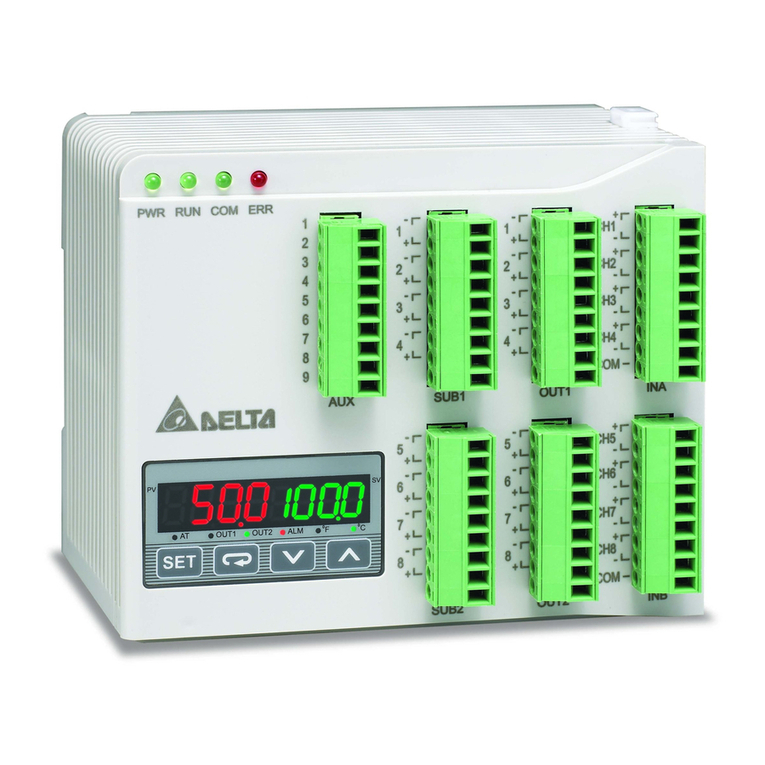
Delta
Delta DTE Series User manual
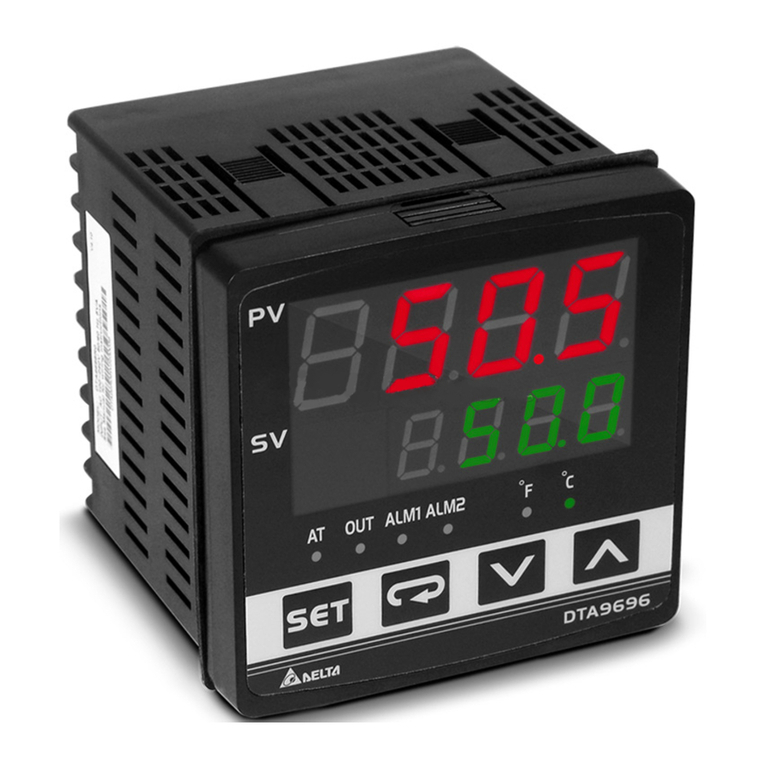
Delta
Delta A Series User manual

Delta
Delta DTE Series User manual
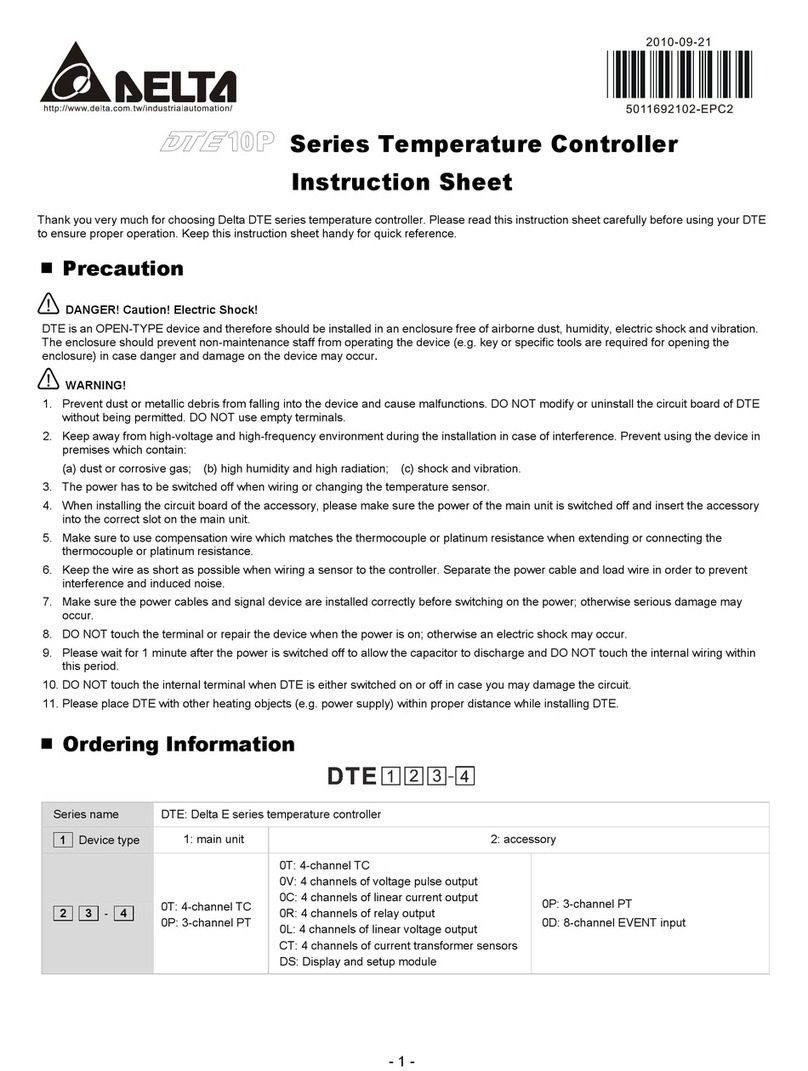
Delta
Delta DTE10P Series User manual
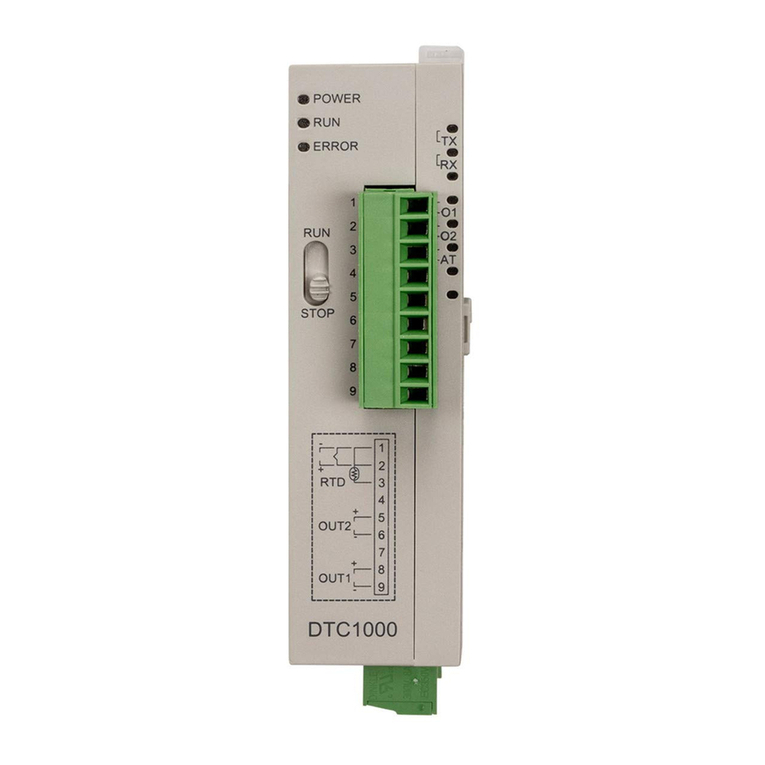
Delta
Delta DTC1000R User manual
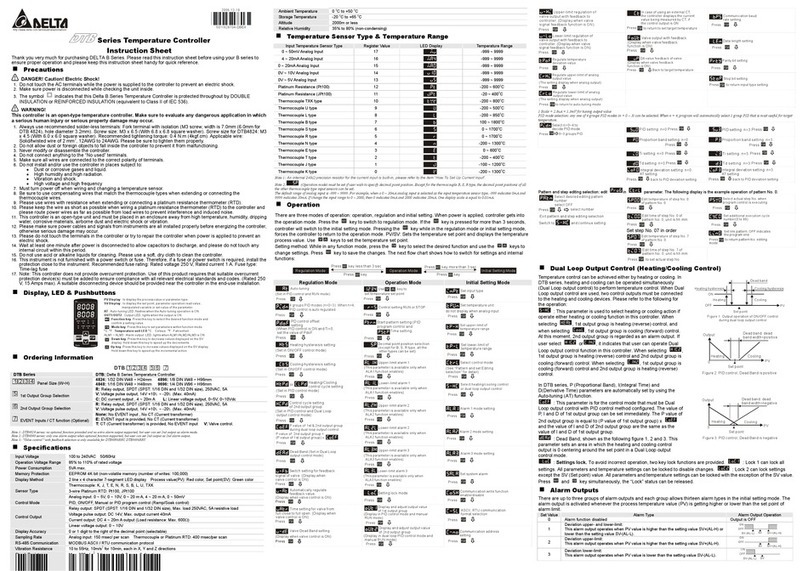
Delta
Delta DTB4824 User manual

Delta
Delta DTB4824 User manual
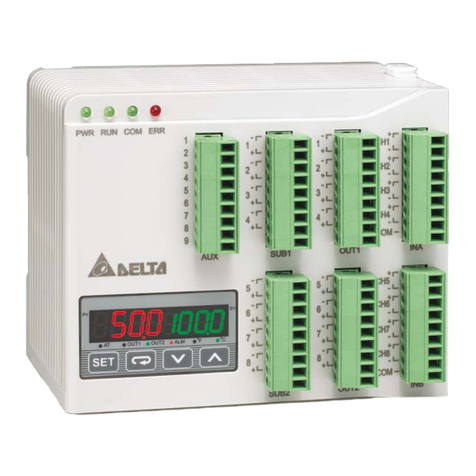
Delta
Delta DTE10T Series User manual

Delta
Delta DTE20T User manual
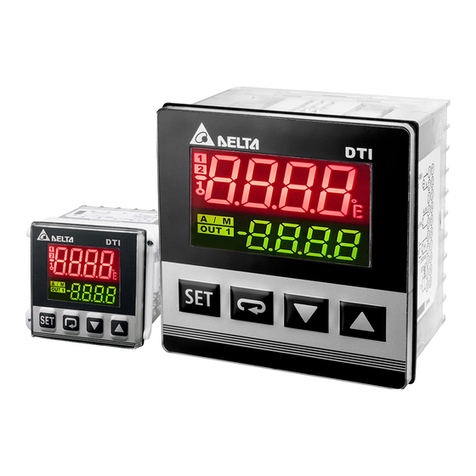
Delta
Delta DTI Series User manual




